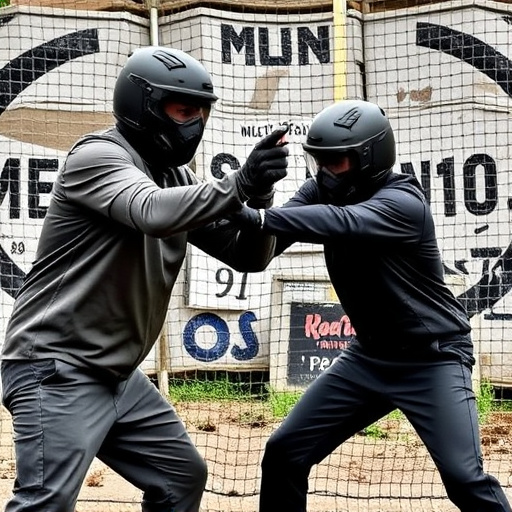Removing pepper spray from clothing post-exposure is vital for safety and comfort. Quick action involves changing, rinsing in cold water, using detergent, and natural deodorizers to eliminate capsaicin residue. Proper decontamination methods, including neutralizing solutions, are crucial after riot control incidents with inflammatory sprays.
In the realm of riot control, inflammatory sprays like pepper spray have long been a game-changer. This article delves into the science behind these powerful tools, exploring their effectiveness and potential health risks. We’ll guide you through understanding how they work, with sections dedicated to safe removal techniques for stubborn traces on clothing—a crucial step after use. Additionally, alternative strategies are discussed, offering a well-rounded perspective on modern riot control methods, including effective measures to take after exposure.
- Understanding Pepper Spray in Riot Control
- The Science Behind Inflammatory Sprays
- Removing Pepper Spray from Clothing Effectively
- Health Risks and Safety Measures
- Alternative Strategies for Riot Control
Understanding Pepper Spray in Riot Control
Pepper spray, a powerful tool in riot control, is designed to incapacitate individuals temporarily through irritation and pain. When deployed during chaotic situations, it disrupts crowd movements and allows law enforcement to regain control. The active ingredient, capsaicin, is derived from chili peppers and creates an intense burning sensation when inhaled or in contact with skin.
While effective for crowd dispersion, removing pepper spray from clothing after exposure is crucial. It’s important to quickly change into clean clothes, wash hands thoroughly, and rinse affected areas with water. Delving into the removal process involves understanding that pepper spray particles adhere to fabrics, making prompt action essential. Using soap and warm water can help flush out the spray, but it’s recommended to follow specific guidelines for safe and effective decontamination, especially when dealing with sensitive materials or textiles.
The Science Behind Inflammatory Sprays
Inflammatory sprays, commonly known as pepper spray, are designed to induce a range of unpleasant sensory and physiological responses in individuals exposed to them. The active ingredient in these sprays, capsaicin, is derived from chili peppers. When inhaled or touched, capsaicin binds to nerve endings, triggering a cascade of chemical reactions that lead to inflammation and irritation. This results in symptoms like teary eyes, difficulty breathing, coughing, and pain—making it an effective tool for riot control and self-defense.
Understanding the science behind these sprays is crucial when considering how to remove pepper spray from clothing. The residue left by inflammatory sprays can remain on fabrics, posing risks of secondary exposure. Proper decontamination techniques involve using neutralizing solutions or specialized cleaning agents that break down the capsaicin molecules. Quick action and thorough washing are essential to minimize discomfort and ensure safety after exposure.
Removing Pepper Spray from Clothing Effectively
After a riot control incident, removing pepper spray from clothing can be challenging but essential for safety and comfort. The first step is to quickly change into fresh clothes, preferably in an area with good ventilation. Pepper spray particles can cling to fabrics, so it’s crucial to act promptly.
Soaking the affected clothing in cold water for at least 15 minutes helps dilute the pepper spray chemicals. You can also use a mild detergent or soap to gently wash the garment, ensuring no residue is left behind. Rinse thoroughly with cold water and repeat if necessary. Using vinegar or baking soda as a natural deodorizer can further assist in neutralizing any remaining pepper spray odors.
Health Risks and Safety Measures
The use of inflammatory spray, often referred to as pepper spray, in riot control presents significant health risks. Exposure can lead to a range of adverse effects, from respiratory distress and eye irritation to more severe complications, especially for individuals with pre-existing conditions or vulnerable demographics. In crowded settings, the risk of inhalation increases, potentially causing panicked reactions and exacerbating existing health issues.
To mitigate these dangers, proper safety measures are essential. Removal of pepper spray from clothing is crucial immediately after use. This involves thoroughly washing affected areas with soap and water, ensuring no residual spray remains. Protective gear, including eye protection and respirators, should be worn by both officers and civilians to minimize direct contact and inhalation. Additionally, having on-site medical personnel ready to provide prompt assistance for those exposed can significantly enhance safety during riot control operations.
Alternative Strategies for Riot Control
In addition to traditional methods like tear gas and rubber bullets, law enforcement agencies are increasingly exploring alternative strategies for riot control. One such innovative approach involves using inflammatory sprays designed to disrupt and dissipate crowds quickly. These specialized products can create a barrier between protesters and authorities, enabling better crowd management.
However, it’s crucial to consider practical considerations beyond the immediate impact. For instance, removing pepper spray from clothing is a critical post-incident procedure to ensure the safety and comfort of individuals affected. Effective decontamination methods, including using neutralizing solutions and specialized cleaning techniques, play a vital role in mitigating the adverse effects of inflammatory sprays.
Inflammatory sprays, like pepper spray, have been a staple in riot control for decades. However, understanding their impact and exploring alternative strategies is crucial. Effectively removing pepper spray from clothing using specific methods can mitigate health risks. While these sprays have proven useful, it’s important to consider the long-term effects on individuals and communities, prompting a continuous search for safer riot control alternatives.
